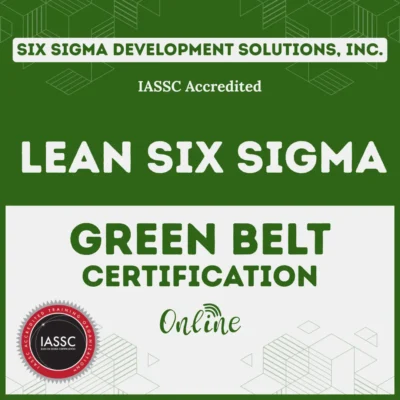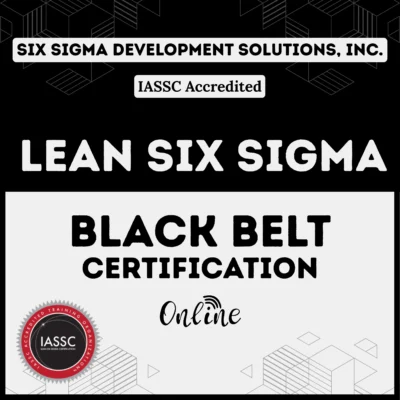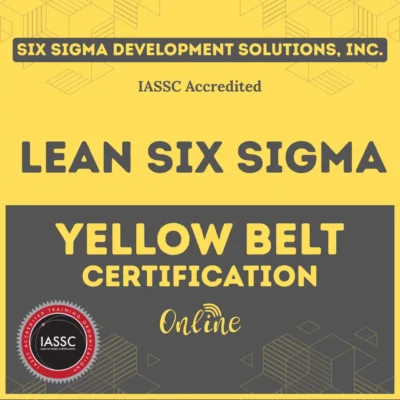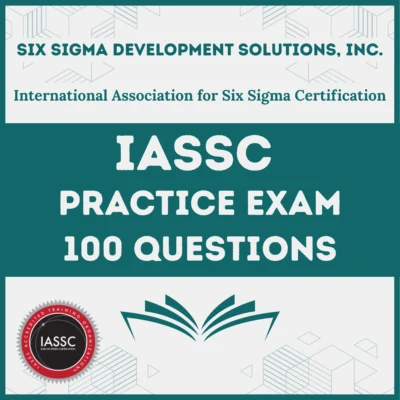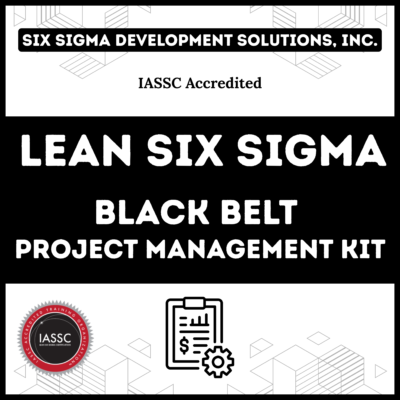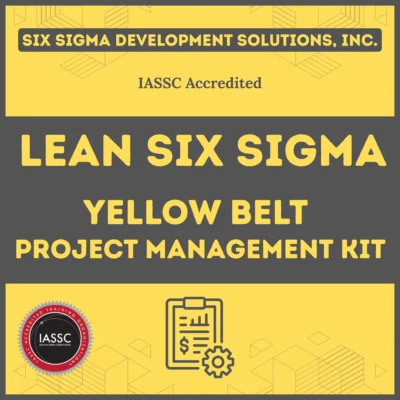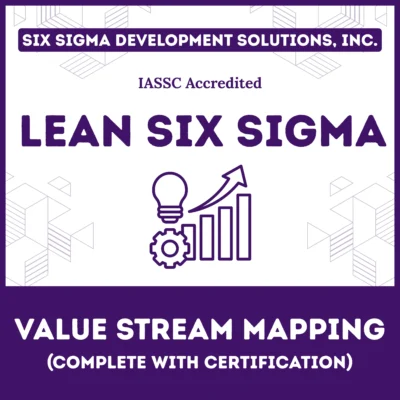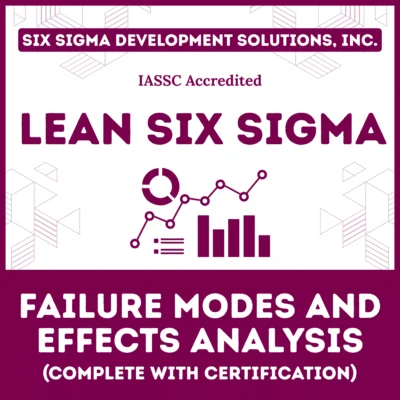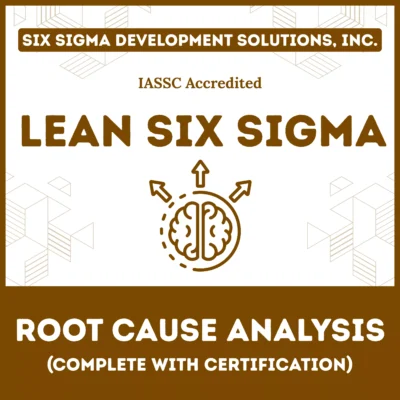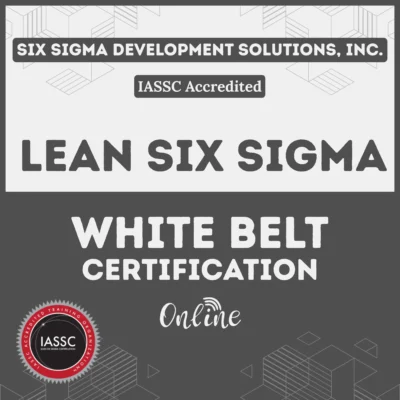Achieving a Six Sigma Black Belt certification is a career-defining milestone for professionals who want to lead process improvement projects and drive organizational excellence. Yet, the journey from training to certification can often seem complex.
This is where Six Sigma Development Solutions, Inc. (SSDSI) steps in — offering a structured path, expert mentorship, and hands-on project guidance that helps learners move confidently from learner to certified Black Belt professional.
Table of contents
Understanding the Six Sigma Black Belt Path
The Lean Six Sigma Black Belt (LSSBB) certification represents mastery of data-driven problem-solving and leadership within process improvement projects. It’s not just about learning tools like DMAIC (Define, Measure, Analyze, Improve, Control) — it’s about applying them to real business challenges.
Students at this level already possess a fundamental understanding of Lean and Six Sigma methodologies (usually from prior Green Belt certification). SSDSI’s program helps them advance these skills into high-impact project leadership roles.
Public, Onsite, Virtual, and Online Six Sigma Certification Training!
- We are accredited by the IASSC.
- Live Public Training at 52 Sites.
- Live Virtual Training.
- Onsite Training (at your organization).
- Interactive Online (self-paced) training,
How SSDSI Supports Students?
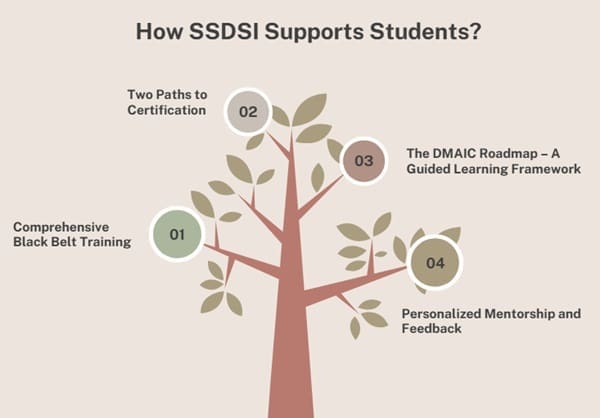
SSDSI doesn’t just train — it transforms professionals into certified project leaders. Let’s explore how the organization bridges the gap between learning and certification.
1. Comprehensive Black Belt Training
SSDSI provides instructor-led, project-focused training that blends theory with simulation. The sessions are designed to help learners internalize Six Sigma concepts rather than memorize them.
Each participant gains access to course materials, DMAIC roadmap files, and toolkits that serve as long-term references.
Key training features include:
- Real-world case studies and project simulations.
- Access to Lean Six Sigma tools such as Minitab or SigmaXL.
- Step-by-step explanations of process mapping, statistical analysis, and root cause identification.
- Mentorship from certified Master Black Belts with decades of industry experience.
By the end of training, each learner not only understands DMAIC but is ready to lead complex change initiatives in their organization.
2. Two Paths to Certification
After completing the course, SSDSI offers two flexible options for certification. This allows students to pursue the route that best fits their professional goals and timelines.
Option 1: Project-Based Certification
In this route, students complete a Black Belt-level project that demonstrates mastery of the methodology.
Requirements include:
- Completing the project within six months after the last day of training.
- Using DMAIC tollgate templates, Excel deliverables, and PowerPoint presentations provided by SSDSI.
- Submitting each project phase to a mentor (Kevin Clay) for review and approval.
Each DMAIC phase (Define, Measure, Analyze, Improve, Control) has its own deliverable structure. Students progress through these tollgates one phase at a time, ensuring mastery at every step.
The end goal: a polished project presentation that showcases quantifiable business improvement — reviewed and validated by an SSDSI mentor.
Option 2: IASSC Exam-Based Certification
Students who prefer an exam route may take the official IASSC Black Belt certification exam.
This path suits experienced professionals familiar with Six Sigma principles who want an independent verification of their knowledge. SSDSI provides detailed guidance, exam preparation resources, and mock tests to help students succeed.
3. The DMAIC Roadmap – A Guided Learning Framework
The DMAIC roadmap is the backbone of SSDSI’s Black Belt journey. It helps learners move systematically through each phase, ensuring complete understanding and application.
What’s in the SSDSI Roadmap Package?
- DMAIC Tollgate Folder: Organized documentation for each phase (five tollgates total).
- LSSGB DMAIC Phase Deliverables (Excel): All mandatory deliverables with color-coded tabs for easy navigation.
- Tool Flowchart (PDF): A visual guide that connects tools to each DMAIC phase, with direct links to articles and glossaries.
- Project Presentation Template (PowerPoint): Ready-to-use slides for final project delivery, including a completed example.
- Certification Requirements (PDF): A checklist specifying every submission requirement for certification success.
These files create a structured, supportive framework — so students always know what comes next.
4. Personalized Mentorship and Feedback
SSDSI stands apart for its personalized guidance. Each Black Belt candidate receives one-on-one mentorship from Kevin Clay, an experienced Six Sigma Master Black Belt.
Here’s how the mentor support process works:
- Students submit the Define Phase tollgate and corresponding files.
- Kevin reviews and provides personalized feedback or requests edits.
- Students refine and resubmit, then proceed to the next phase.
This iterative review process continues until the project is complete, turning every submission into a learning experience.
By following this model, SSDSI ensures quality, accuracy, and readiness before final certification.
What’s Next? How to Get Certified
Once your project or exam is completed, the final steps are straightforward.
If you’ve taken the project-based path, submit your final PowerPoint presentation to your mentor. They’ll review it and may request a live presentation via Teams or Zoom. After approval, your certification will be issued.
If you’ve opted for the IASSC exam, you’ll receive guidance on registration, test-taking tips, and next steps for displaying your achievement.
Either way, SSDSI celebrates your success and helps you position your credential professionally on LinkedIn and your resume.
Resources for Continued Success
Even after certification, SSDSI encourages continuous learning. Graduates gain access to exclusive tools and communities to help them stay sharp and updated.
Some useful resources include:
- isixsigma.com: A comprehensive Lean Six Sigma knowledge hub.
- minitab.com: Tutorials and data analysis tips.
- YouTube: Visual guides on statistical tools like SigmaXL and Minitab.
Students can always email [email protected] or schedule one-on-one time for post-certification mentoring.
Also Visit: Online Lean Six Sigma Black Belt Page
Why Choose SSDSI for Your Black Belt Journey?
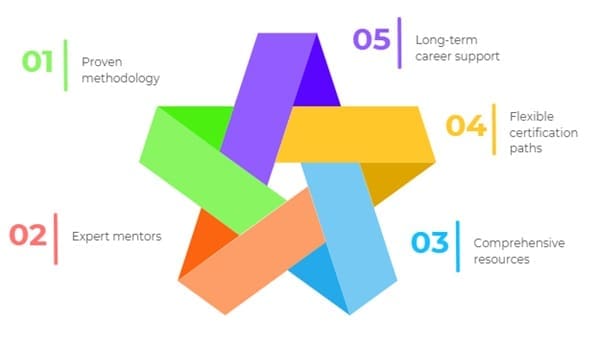
Becoming a Six Sigma Black Belt isn’t just about training—it’s about transformation. SSDSI’s commitment to practical learning, mentorship, and real-world application makes it one of the best choices for professionals seeking to master Lean Six Sigma.
Here’s why SSDSI stands out:
- Proven methodology: Real projects, not just theory.
- Expert mentors: Learn directly from certified Master Black Belts.
- Comprehensive resources: From DMAIC templates to toolkits, every file is structured for success.
- Flexible certification paths: Choose between project-based and IASSC exam-based options.
- Long-term career support: Guidance beyond certification to apply skills in your organization.
Real Impact of SSDSI’s Black Belt Program
Graduates of SSDSI’s Black Belt program often experience measurable impact in their careers:
- Increased confidence in leading cross-functional teams.
- Higher earning potential (often 20–30% pay increase).
- Enhanced ability to identify process inefficiencies.
- Recognition as change leaders within their industries.
This success is no coincidence; it reflects the program’s blend of hands-on learning and structured guidance.
Frequently Asked Questions (FAQs)
Q1. What is the difference between project-based and exam-based Black Belt certification?
Project-based certification tests practical knowledge through hands-on application of DMAIC tools. The IASSC exam-based certification, on the other hand, validates theoretical mastery through a standardized test.
Q2. Do I need prior Six Sigma experience to join the Black Belt program?
It’s recommended that you hold a Green Belt or equivalent experience. SSDSI also provides preparatory materials to help you get ready.
Q3. How long does it take to get certified after training?
Typically, certification can be earned within six months, depending on your chosen path and project complexity.
Q4. What software tools are used in the SSDSI program?
Students typically use Minitab, Excel, or SigmaXL for data analysis and process improvement.
Q5. Who can I contact for guidance during the certification process?
You can email Kevin Clay at [email protected] for personal mentorship and support.
Final Words
Earning a Six Sigma Black Belt certification is no small feat — it reflects deep analytical skill, leadership, and process excellence. SSDSI empowers students to reach this goal through structured training, real-world application, and unwavering mentorship.
Whether through a project-based certification or IASSC exam, students have everything they need to achieve success — and transform both their careers and their organizations.
SSDSI doesn’t just issue certifications — it builds confident, capable change leaders who know how to make measurable impact.

About Six Sigma Development Solutions, Inc.
Six Sigma Development Solutions, Inc. offers onsite, public, and virtual Lean Six Sigma certification training. We are an Accredited Training Organization by the IASSC (International Association of Six Sigma Certification). We offer Lean Six Sigma Green Belt, Black Belt, and Yellow Belt, as well as LEAN certifications.
Book a Call and Let us know how we can help meet your training needs.






